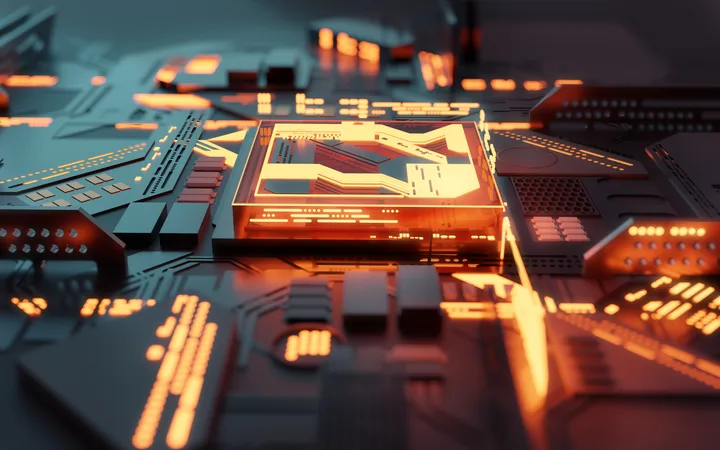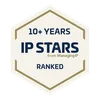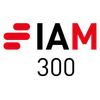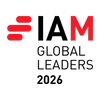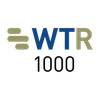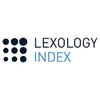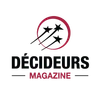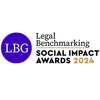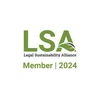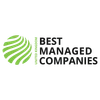Quantum computing promises major advances in various technical areas such as secure IT architectures, metrology, sensing devices as well as drug development and materials engineering. #
Research and development into the field of quantum technologies across multiple fields has made remarkable progress in the last decade, and it is no surprise therefore that this has led to increased patent activity.
Physical Realisation of the Quantum Computer #
Whilst the timeline of quantum computing can be traced back to the 1960’s it is really the 1980s where work really accelerated. Pioneering works of Richard Feynman, Paul Benioff, David Deutsch and others demonstrated how a quantum bit, or a qubit, could be used to perform computations, instead of the classical bit used in ordinary computers.
The qubit basis states 0 and 1 are noted |0> and |1> respectively. Unlike the classical bit, which is either 0 or 1, at any given time, a qubit can be in a state of superposition in which it is part zero and part one. Any state of the qubit can therefore be represented as a vector in the form of a complex combination of |0> and |1>, which can be noted: |v> = α |0> + i. β|1> . When the qubit is measured, the result is either |0>, with a probability of α, or |1>, with a probability of β. A Bloch’s sphere is often used to represent the qubit states as vectors (|v>) connecting the centre of the sphere to various points on a surface thereof. The qubit basis state |0> can be represented by the red vertical arrow (ϑ = 0 ), while the basis state |1> is represented by the vertical green arrow pointing in the opposite direction (ϑ = π).

In principle, any quantum mechanical system on which it is possible to encode two identifiable states can be used to make a qubit. When an electron is used as the qubit, the state thereof is the intrinsic angular momentum or the spin of the electron. Referring to the figure above for instance the basis state |0> would correspond to a spin-up of the electron while the basis state |1> would correspond to a spin-down thereof. A photon may also be used as a qubit, in which case, a direction of polarization, either vertical or horizontal, can encode the two basis states.
In the last decade, the field of quantum computer devices has witnessed the adoption of a number of promising technologies to realise qubits. These quantum technologies are based on various materials including semiconductors, ion traps, crystals, non-abellian anyons and superconductors circuits. Superconducting quantum computers such as Superconducting Quantum Interference Devices, or “Squids”, have gained momentum as a leading technology in the race for building a functional quantum computer.
To manipulate the qubit, a quantum computer would typically hit or blast the qubit particles with light -either microwave or laser pulses - to cause each qubit to flip from one state to another. The wide range of technologies available today to fabricate a qubit, is testimony that the field of realising quantum computer is still emerging.
Challenges of Quantum Computers #
Practical difficulties of quantum computing today include the problem of decoherence, which is caused by unwanted interaction of the qubit with the environment. Through decoherence, the qubits uncontrollably change their quantum states, which makes the quantum computer prone to errors and loss of stored information. Present quantum computers of the Noisy Intermediate Scale Quantum or NISQ era are particularly subject to electromagnetic noise, errors at qubit gates and errors in the measurement of the qubits’ state. These errors limit the complexity of the quantum circuits that can be implemented at present. Most recent quantum systems using thousands of qubits have been unveiled, however scaling further up, the number of qubits remains a huge technical challenge. To realise quantum computers with hundreds of thousands, preferably millions of qubits, research and development activities are being carried out in the field of quantum error correction/mitigation.
Advantages of Quantum Computers over Classical Computing Systems #
When the major hurdles faced by quantum computers are overcome, they promise exceptional superiority in solving certain types of problems. Quantum computers manipulate qubits in a state of superposition, in which the qubit exists as state 0 and state 1 simultaneously with probabilities for each state. ‘N’ qubits in superposition states carry 2^N bits of information. Hence a small number of qubits in superposition states carries an enormous amount of information. A quantum computer that manipulates N qubits would manipulate all these 2^N bits in parallel in a single operation, which gives it the potential to be an incredibly powerful computational device.
Owing to this parallelism, manipulation of the qubits using quantum algorithms allow quantum computers to perform exceptionally faster than conventional computers. Manipulation of qubits provide dramatic speedups for specific problems such as breaking cryptographic codes, factoring a large number, search and optimisation, modelling systems, solving large systems of linear equations, forecasting the weather and so on.
Patent Trends #
The challenges faced by quantum computers and the opportunities promised by the field, have led to numerous innovations and patent application filings in recent years. The EPO published a report in early 2023, which clearly shows that the number of inventions in that field multiplied over the last 10 years, and is well above the generally observed increase in all fields of technology. The figure below shows an evolution of the number of International Patent Families in the field of quantum computing (grey bars) and in all technical fields (red line). The number of International Patent Families in the field of quantum computing has been growing exponentially and this upward trend shows no signs of slowing down.

The following graph shows applications and patents trends of the technology identified by the IPC group “G06N 10” which encompasses quantum computing technologies. These include “Quantum computing”, its “Physical realisations”, “Models”, and “Algorithms”, “Quantum error detection/correction”, and “Quantum programming”. This chart, which is obtained using PatSnap®, shows the number of grants or issued patents resulting from applications filed in the same year. For instance, if a 2012 patent application is issued in 2014, the issued patents appear in 2012 in orange.
The decreasing trend of the grant rate in recent years is explained by the fact that a number of applications filed in the last few years have not granted yet. It is not an indication that the technology is heading towards stagnancy. The small number of applications filed between 2011 and 2018 (below 1000) and the high grant rate of applications filed in the same period (above 80%) are an indication that the technology is emerging.
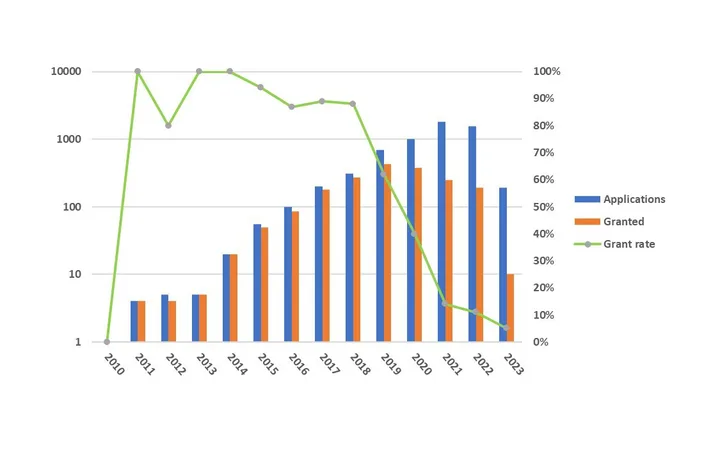
The following diagram, also obtained using PatSnap® in September 2023, shows geographic locations where patent applications relating to inventions in IPC group “G06N 10” have been filed. It identifies the USA and China as the top jurisdictions, in which 30.68% and 25.88% respectively of all patent applications in this field had been filed.
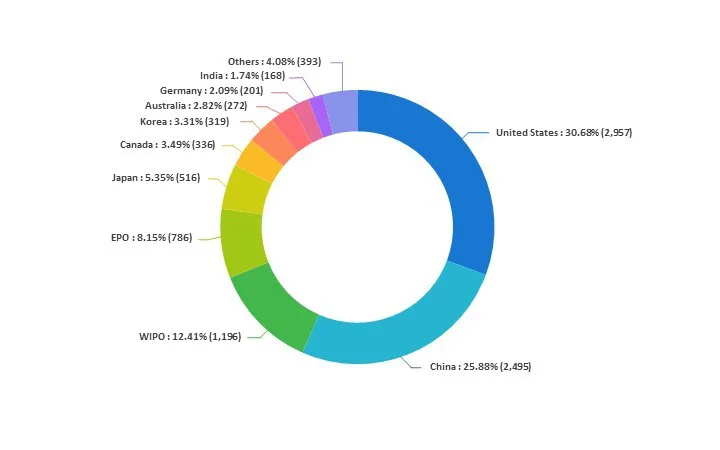
The following graph shows companies having the largest patent portfolios in the technology identified by IPC group “G06N 10”. IBM being the largest player.
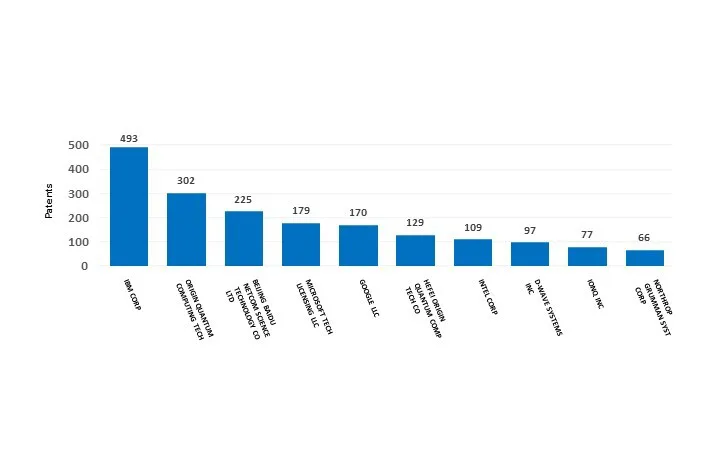
It is said that the quantum parallelism inherent to quantum computing is particularly adapted to implement Artificial Intelligence/Machine Learning techniques, as neural networks, for example, are often presented as “embarrassingly parallel”. The dynamic patent trend in the field of quantum computing as a whole can also be observed in the field of artificial intelligence/machine learning. The development of the latter sub-sector, which only began in the last decade is exhibiting (although not shown above) even higher momentum than that of the individual sub-sectors of the field of quantum computing.
Quantum Simulation #
The emerging field of quantum simulation involves the modelling of a complex quantum mechanical system by another system, under controlled conditions, to systematically study and predict the behaviour of the simulated system. The EPO published in June 2023, a further report to provide an overview of important patent trends in the field of second-generation (2G) quantum simulation technologies. The second-generation (2G) of quantum technologies is seeking the precise control of quantum-physical properties and behaviour of individual or small number of particles such as atoms and photons. The following graph shows the number of International Patent Families in the field of Quantum simulation and in all fields of technology. While the number of inventions in the field of 2G quantum simulation is still rather low, it has increased dynamically over the last decade at a rate which is well above the increase generally observed across all fields of technology. In particular, a steep increase is observed starting from around 2017.

Conclusion #
Today’s quantum computers are rather limited in their number of qubits and their ability to correct or mitigate errors. These limitations undermine their ability to run demanding and ambitious applications. However, quantum computers are improving quickly, and several promising technologies are being explored to develop more stable and powerful quantum computers. The EPO studies show that, although patents numbers in the field of quantum computing are relatively low, the momentum of increase is much higher than that of all other fields of technology. The recent EPO reports on quantum computing and simulation technologies are intended to capture early trends of these dynamically developing fields and to anticipate how they may develop further.
To find out more about patents for quantum computing, please contact our specialist team.
